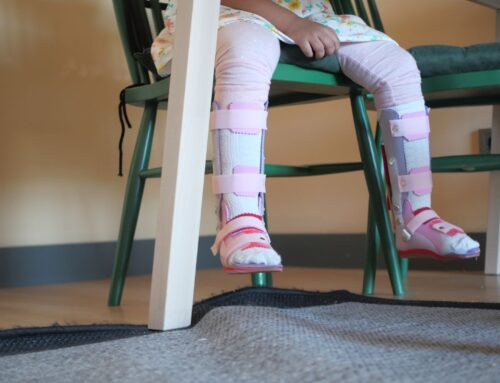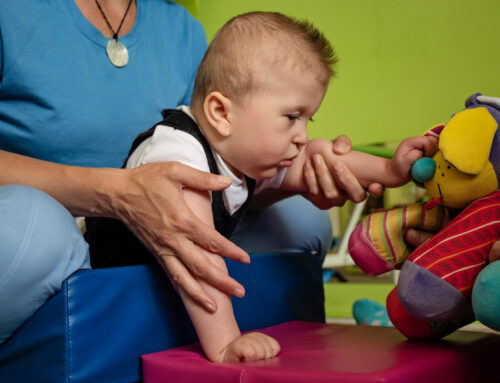Erb’s palsy is a nerve injury that occurs during childbirth and can affect the child’s ability to feel and use the arm. Erb’s palsy treatment for toddlers aims to promote motor recovery, muscle strength and prevent disability, helping children lead full and active lives.
In this blog, we will explore how physiotherapy can be a powerful tool in treating Erb’s palsy, helping these little ones regain strength, mobility, and independence.
Table of Contents:
- Erb’s Palsy Causes
- Erb’s Palsy Symptoms
- Physiotherapy: A Crucial Component of Erb’s Palsy Treatment
- The Importance of Consistency
- Measuring Progress
- Challenges in Treating Erb’s Palsy
- Conclusion
Erb’s Palsy Causes
Erb’s Palsy is caused when there is an injury to the group of nerves (brachial plexus) that supply the arm, often leading to paralysis. Specifically, this injury occurs at the nerve root of C5-C6, which is a region of the spine.
This injury typically occurs in the childbirth process. During delivery, excessive traction of the baby’s neck can lead to injuries causing Erb’s Palsy. Two of the most common risk factors include a large fetus, as well as shoulder dystocia meaning the baby’s shoulders get stuck during delivery.
Statistically, it is a common birth injury that occurs between 0.9 to 2.6 times for every 1000 live births.[i] The good news is that with early diagnosis and treatment including physiotherapy90 percent of Erb’s Palsy cases will resolve with time.[i]
Erb’s Palsy Symptoms
The classic signs and symptoms of Erb’s Palsy include:
- The Waiter’s tip deformity, which is characterized by the arm hanging by the side with the shoulder internally rotated, the elbow extended with forearm turned in and wrist is flexed.
- The arm cannot be raised from the side; all power of flexion of the elbow is lost, as is also supination of the forearm.
- Loss of sensation on the lateral part of the arm. This position is due to damage and compromise of the axillary, musculocutaneous and suprascapular nerve.
Physiotherapy: A Crucial Component of Erb’s Palsy Treatment
Range of Motion Exercises
Exercises and movement therapy are a crucial component of the treatment plan and can begin as soon as a diagnosis is made. Activities and exercises aim to promote motor recovery and muscle strength, limit joint stiffness and prevent pain and disability.
Movement-based approaches can also be strengthened and promoted using tools such as kinesiotaping and constraint induced therapy (a movement approach that forces selective movement of the affected limb).
One study sought to use range of motion (ROM) exercises for the upper extremities initially followed by active ROM and muscle enhancement exercises in the following months. They found that passive ROM exercises are effective at treating Erb’s Palsy as range of motion improved over time. However, the timing and frequency of exercises for recovery was inconclusive.[ii]
Electrical Stimulation Treatment
Neuromuscular electrical stimulation uses a device to send electrical impulses to the nerves to help improve the strength of the muscle. One study approached treatment by electrically stimulating each muscle group found in the shoulder, elbow and wrist for 15 minutes, three times a week for six weeks. As a result, range of motion increased dramatically for the shoulder, elbow and wrist[iii]
A physiotherapist or occupational therapist is able to assess, prescribe and guide the process of electrical stimulation treatment and progression.
Virtual Reality
One area that is gaining increasing interest in study is the use of virtual reality to promote movement. One study looked at the use of virtual reality (VR) on a group of children with an average age of six years old.
The study found that virtual reality was more effective than conventional physiotherapy at treating Erb’s Palsy in children of this age. Those treated using virtual reality experienced greater range of motion (ROM), strength and should abduction (ability to move arm away from body) than children treated with traditional methods.[iv]
One reason why the researchers believe VR is so effective is because it allows children to practice and learn without fear of experiencing an injury and it gives them a sense of personal control and accomplishment which leads to greater motivation during therapy.
This is an important finding that can apply to many aspects of physiotherapy as increasing motivation and pushing the boundaries of what we think we can accomplish can lead to greater healing and recovery through greater confidence
The Importance of Consistency
Consistency in physiotherapy sessions and home exercises is paramount for the successful treatment of Erb’s palsy. Regular visits to the physiotherapist and adherence to the prescribed exercise regimen can yield significant improvements over time. Parents and caregivers play a crucial role in maintaining this consistency and ensuring their child receives the necessary care and support.
Measuring Progress
Tracking progress is an essential part of Erb’s palsy treatment. Physiotherapists use various assessment tools and measures to monitor the child’s development. Over time, improvements in range of motion, muscle strength, and functional abilities should become evident, giving hope to both the child and their family.
Challenges in Treating Erb’s Palsy
While physiotherapy offers a promising path to recovery for toddlers with Erb’s palsy, it is important to acknowledge that the journey may not always be smooth. Some challenges that children and their families may face include:
- Emotional and Psychological Impact: Dealing with a physical impairment can be emotionally challenging for both the child and their family. Supportive counseling and therapy can help address these emotional aspects of treatment.
- Time and Patience: Recovery from Erb’s palsy is a gradual process that requires time and patience. Setting realistic expectations and celebrating small milestones along the way can help maintain motivation.
- Surgical Intervention: In severe cases of Erb’s palsy, surgery may be necessary to repair the damaged nerves or muscles. Physiotherapy is often an essential component of postsurgical rehabilitation.
- Long-Term Care: Some children with Erb’s palsy may require ongoing physiotherapy and support well into adolescence. Continuity of care is crucial to ensure that they can lead fulfilling lives.
Conclusion
Erb’s palsy is undoubtedly a challenging condition for toddlers and their families. However, with the dedicated care and expertise of physiotherapists, there is hope for these young ones to regain their strength, mobility, and independence.
Early intervention, personalized treatment plans, and a commitment to consistency are the keys to success in treating Erb’s palsy through physiotherapy.
We are Here to Help
All of our physiotherapists at Propel Physiotherapy are skilled in treating conditions like Erb’s Palsy. Specifically, Tania Bhogal in Etobicoke, Alanna Holz in Pickering, and Christine Davies who practices in Peterborough have additional experience working with infants, toddlers and children in pediatric physiotherapy.
References
[i] Basit, H., Ali, C. D. M., & Madhani, N. B. (2023, April 8). Erb Palsy. National Library of Medicine.
[ii] Şahin, N. (2018). Effect of exercise doses on functional recovery in neonatal brachial plexus palsy: A randomized controlled study. Northern Clinics of Istanbul. https://doi.org/10.14744/nci.2017.29200
[iii] Okafor, U., Akinbo, S., Sokunbi, O., Okanlawon, A., & Noronha, C. (2009). Comparison of electrical stimulation and conventional physiotherapy in functional rehabilitation in ERB’s palsy. Nigerian Quarterly Journal of Hospital Medicine, 18(4).
Written by






